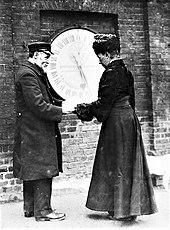Image courtesy of the Science Museum Blog.
In the first four decades of the twentieth century, Ruth Belville—alongside her modest pocket-watch—sold time as part of her family’s business. But to truly understand her story, we must understand why she sold time. Prior to the nineteenth century, people kept time by referencing the position of the sun: the sun’s peak meant it was noon, and midnight was when the peak was furthest away. When mechanical clocks were invented, towns and cities began keeping a local time, meaning that noon would be exactly twenty-four hours after the previous noon. Time zones were also adopted in the mid-nineteenth century to standardize time across vast regions. Such standardization allowed for synchrony across cities and states in proximity to each other, a phenomenon that frequent travelers and railroad companies especially appreciated. Unsurprisingly, most people began using mechanical clocks. Though these clocks were more reliable than others, they were still not entirely accurate. For example, such clocks would slowly deviate from the local mean time (determined by the time zone). It is in this context that the story of the Belville family arises.
In London, the Royal Observatory in Greenwich was responsible for keeping the time. To signal the time to the public, the Observatory would raise a balloon above the building at precisely p.m. every day. Later, the Observatory installed a large clock on its gate so that anyone could see the accurate time at any moment rather than waiting for a signal. However, to view this clock, people had to physically make a trip from their homes and offices across London to the Observatory, which of course, was inconvenient. Moreover, calibrating watches and clocks in the nineteenth and early twentieth centuries was more complicated than it is today, requiring some level of expertise. Seeing this as an opportunity to profit, John Belville, an assistant at the Royal Observatory, began visiting a network of two hundred clients around London once a week, calibrating their watches and clocks with his own pocket watch, which he calibrated with the Greenwich mean time daily. This business passed to his wife when John died, and then to his daughter Ruth.
As with any business, the Belville family service faced competition, particularly when Ruth took over after her parents’ deaths. Telegraphs were capable of signaling time, and different firms would compete to sell their telegraph time service. Nevertheless, Ruth had an advantage: electric telegraphs were not as accurate nor as reliable as her state-of-the-art pocket watch, which was accurate to the tenth of a second. Moreover, the firms selling telegraph time had trouble keeping their services in order and received many complaints. Ruth, however, was reliably consistent and professional. Indeed, the watch’s accuracy and familiarity with the Belville family business made it an easy decision for clients to remain subscribed to this service.
Ruth Belville carried that pocket watch—which she fondly called “Arnold”—around London every week for forty-eight years. Each day, she would visit up to ten customers across London, from the outskirt docklands to the central Mayfair. Over these forty-eight years, radio became a prominent method of communication (including communication about time), and the electric telegraph also became more accurate and reliable. However, there was still a market for Ruth’s service—the new technologies did not simply replace the older ones. Instead, they co-existed for quite some time.
Eventually, however, modern technologies outpaced Ruth’s pocket watch. The invention of the telephone speaking clock, which gave the precise time on the third stroke, signaled to Ruth that her pocket watch could no longer compete with more efficient and accessible modes of communication provided by modern technologies. She finally retired at the age of eighty-six. In all, the Belville family business spanned 104 years, from 1836 to 1940. Before Ruth passed away in 1943, she donated Arnold to the Clockmakers’ Company Museum.
Today, we are all accustomed to seeing the time on our phones and digital watches. The Belville family business story is a tale of the industrializing world, a world filled with the clashing of the old and the new.

